Partner of The Spartan Group: The status quo of the Metaverse project reminds me of Web 3 in 2017
Original author: Jason Choi, partner of encryption venture capital The Spartan Group
Over the past year, we've interviewed more than 50 Web 3 Metaverse companies.
Summarize my harvest today.
The "Web 3 Metaverse" refers to digital virtual worlds, often with some element of user ownership through tokens or NFTs.
infrastructure
infrastructure
Experience layer (in-world)
Value-added layer (out-of-world)
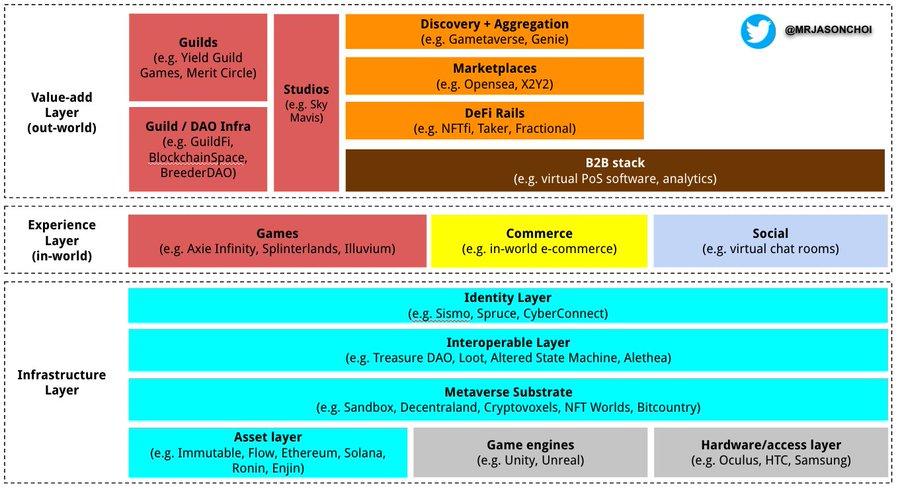
A common metaphor is: metaverse = game.
But a better analogy is Layer1
Like L1, Metaverse is a platform for developers to create experiences + services.
Like L1 in 2017, we saw more people creating the metaverse than building things on top of the metaverse.
While the potential market for open world MMORPGs (massively multiplayer online role-playing games) is large, I think the largest virtual worlds will consist of more than just games.
Similar to the "fat protocol", the winning Metaverse Substrate layer will be more valuable than any single application.
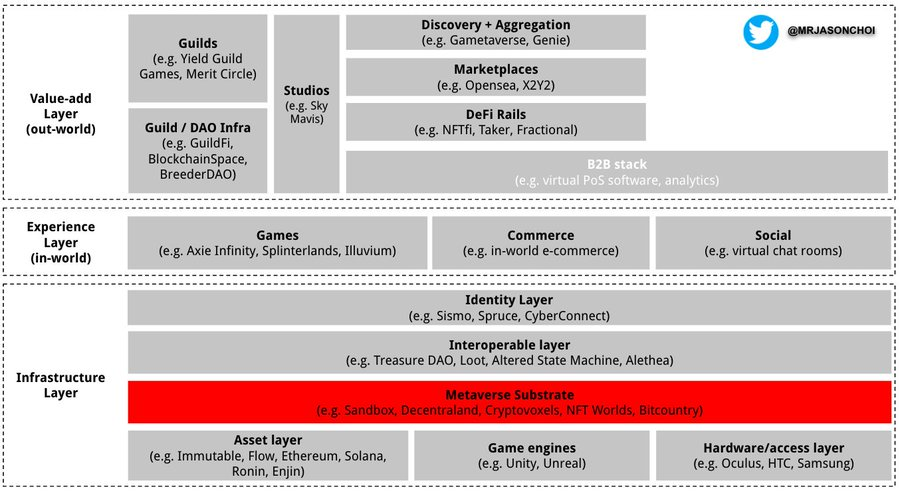
Many of the companies we've interviewed and invested in are building intrinsically augmented, user-owned MMORPGs.
@AxieInfinity @illuviumio @staratlas @decimated_game are some examples - ie familiar gaming experience + ownership of in-game items via NFTs.
"Game" sounds trivial, but is not snubbed and ignored!
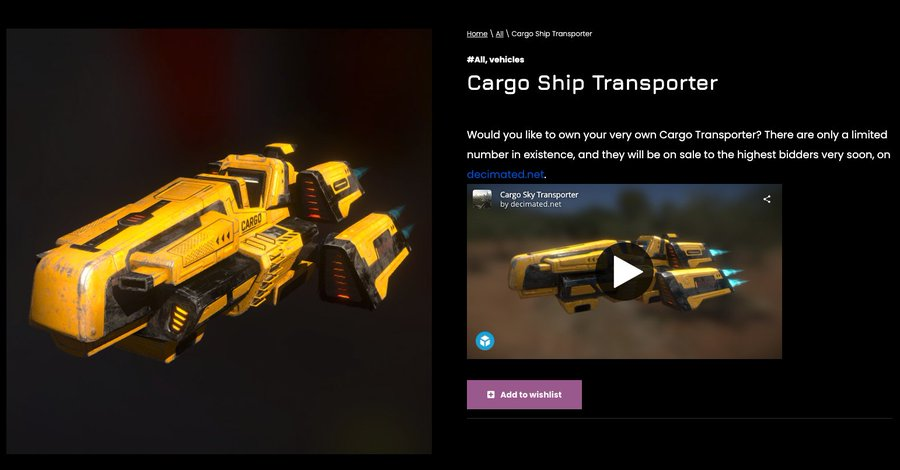
2021: 61% of Blizzard's $8.8 billion in revenue comes from in-game purchases. Recently acquired by Microsoft for $68 billion.
In 2021, AXS generated $1.3 billion in revenue and is valued at $14 billion today.
P2E gaming presents a huge opportunity and has spawned infrastructure companies (eg $LOOKS $GF $GUILD), tools (eg @CrucibleNetwork) and a $550M guild market (eg $YGG $MC). With 1,100 gaming guilds and 1 million players, guilds are arguably the largest use case for DAOs today.
While P2E gaming is exciting and could evolve into more games, the $1 trillion top opportunity lies in creating a virtual world where gaming is just one of many use cases.
Imagine a generalized virtual world - permissionless creation + commerce, defined by immutable digital rights.
Similar to how Facebook replicated our social experience on one digital platform, the winning metaverse will bundle multiple use cases into one open virtual world.
We've seen various companies offering metaverse events and storefronts as a service, though many are premature.
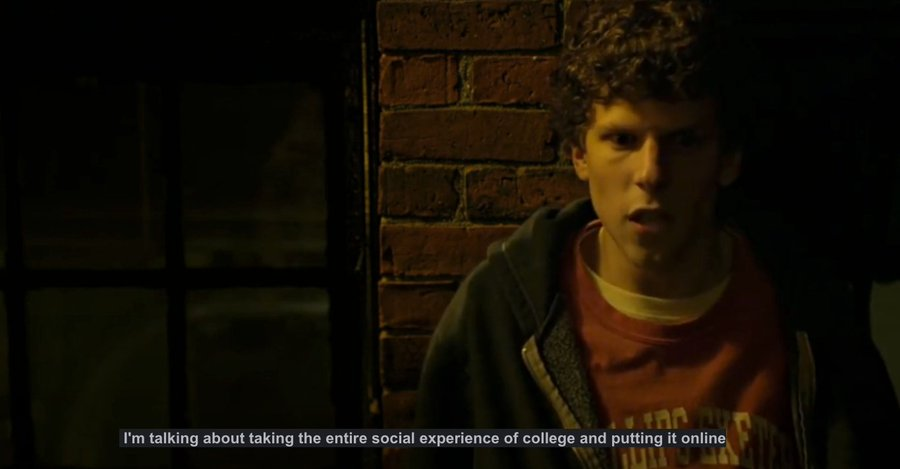
Several projects have built a common foundation for realizing this vision, but we may still be 5 to 10 years away from full maturity. These items include@Decentraland @theSandboxGame @SomniumSpace @cryptovoxels @NFtworldsetc.
The best chance of success is creating an open alternative to what Meta is trying to create.
A platform on which any developer can build social, entertainment, work, education, and business experiences accessible to any user.
But we're still in the early days.
For example, while you can explore and play games in @decentraland today, the experience is still hard to describe
Most metaverse purchases we see are still NFT buys and sells, and most are just redirect links to OpenSea.
Some of the projects we interviewed are doing PoS and storefronts within the Metaverse world.
As ambitious as metaverses are, they also face a cold start problem: how do you incentivize developers to build on top of new metaverses when there is more value to be gained by building their own metaverses? (Look at various $LOOT forks). How to let the user join a blank virtual world?
One solution we see is lowering the barrier to creating in-world experiences. For example @nftworldsNFT uses Minecraft (not Unity) to create their worlds. This leverages a suite of behaviors with over 130 million MAUs that many are already familiar with.
Since most virtual landowners are still passive speculators, the metaverse world rental model will also facilitate development.
Users can rent out land for a development store to build in exchange for a fee.
This is something that can currently be done in-game using @nftworldsNFTs, but could be promoted with new DeFi models.
The third common solution we see is specialization.
Instead of starting a general Metaverse, some teams choose to expand and improve within a niche community.
For example @Cryptovoxels started out as an arts-focused metaverse, but there's no reason it couldn't expand into other areas.
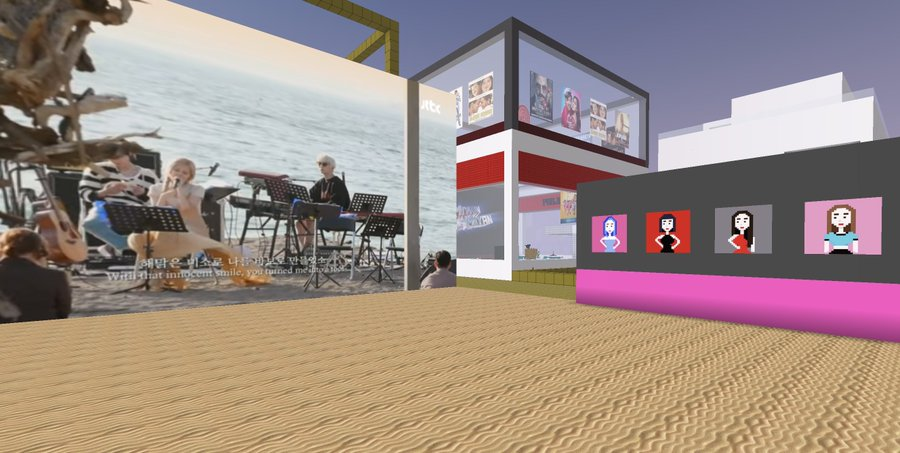
In terms of raising - most metaverses we come across raise funds through token sales or land sales.
My initial hunch was that at maturity, land should be worth more than the world's trading currency.
Today, that's not surprising.
All in all, I believe that as digital experiences become more immersive over time, a Metaverse is inevitable.
The fact that Facebook (Meta) is willing to spend $10 billion to make this happen not only increases its likelihood, but also increases the need for a user-owned alternative.
The current state of Metaverse projects reminds me of Web 3 in 2017.
Many ideas are out of touch with today's technological constraints, but there is also plenty of anecdotal evidence that product-market fit is just around the corner.
In the end, the idea of a Web 3 metaverse might be 1, 5, or 10 years away before something big happens...
But we are committed to doubling down and helping to solve this problem together.
Original link



